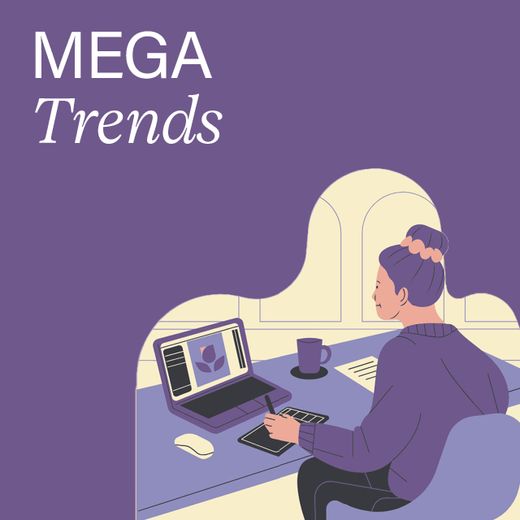Eight days a week: what’s the relationship between office working and creativity?
We need to focus on what boosts creative thinking, not where.

- 5 minute read
- Future of Work
Does working in an office make people more or less creative? Last month, addressing the BCC Conference, Chancellor Jeremy Hunt expressed concern that working from home was leading to a “loss of creativity” in business. He said that, in the future, employers should tell their people “the default will be you work in the office.”
Though no artist himself, his words echoed the more creatively credible views of Bob Iger, CEO of Disney, who proclaimed in January: “in a creative business like ours, nothing can replace the ability to connect, observe and create with peers that comes from being physically together.”
Since the dramatic introduction of From Home and then a gradual shift to Hybrid Working following the pandemic, we’ve seen a lot of debate about the merits of which work setting is best – from the ‘all from home’ beliefs of Airbnb’s Brian Chesky to the ‘office is best’ insistence of Goldman Sachs CEO, David Solomon.
Often both sides cite very similar arguments: young people want to be back at the office AND working from home; both working from home AND the office promotes mental wellbeing; they simultaneously make workers both more AND less productive etc.
Creativity is just one more commodity to be sold in that particular marketplace of ideas.
There are two problems with arguing for these positions. First, evidence based on measurable data – as opposed to just vibes – simply does not exist. There is no ‘knockout blow’ that defeats either position because different businesses’ needs are unique and nuanced.
Second, when you are talking about something like creativity in business – as opposed to, say, mental wellbeing – you are usually talking about a team activity. Business creativity is rarely a lone artist locked in a garret; mostly, it’s a writers’ room.
What factors make a place a more or less creative place for a team to work?
While it’s true people can be creative in a wide variety of locations, what maximises the chances of it happening either in your office or in your colleagues’ homes? Because there has been plenty of research and academic study of this question – certainly enough to draw some broad lessons to apply, regardless of the idiosyncrasies of your business or sector.
In our view, though there are many ways workplaces can be made more creative, the three most important things to focus on are:
Role of leadership
While there has been a lot of historic research linking leaders’ behaviours to creativity, recently a lot more focus has been on the importance of leaders creating the best ‘context’ for creativity to thrive.
This means creating an inclusive leadership style, to foster team creativity through stimulating all members of the team with questions instead of answers, creating clarity and setting boundaries within which they should be free to take risks and feel trusted to explore new approaches.
Diversity of Team
This facilitation starts, of course, with the creation of the team itself and beliefs about the value of differences in the team. And while there is lots of evidence of the importance of creating diverse teams to drive business success – profitability, outputs and productivity – it’s also important to recognise the role diversity plays in creativity: bringing new perspectives, challenging received views and generating the ideas that will develop new solutions.
Psychological safety
Google’s now famous “re:Works” internal study on teamwork found the most significant influence on team success is psychological safety, which is how comfortable team members are in sharing ideas and being vulnerable with one another. Nowhere is this more true than in the ways it fosters creativity: creating conditions in which people feel safe to criticise and discuss ideas freely without people feeling personally attacked or foolish for having suggested something. Or that their own job or future career is on the line for the way they think.
It’s time to focus on creating the conditions for creativity
If I may be permitted a historic indulgence around the idea of creativity and home vs office, it’s worth noting that one of the most creative teams of the last century went through these same challenges fifty years earlier.
At the start of their careers, The Beatles relied heavily on ‘in-office’ style working: writing songs “eyeball-to-eyeball” in hotel rooms and tour buses, rehearsal spaces and studios. It was only when they became rich enough to stop touring and live apart that they developed their ‘hybrid model’ of writing alone and coming together in the studio to unleash the team creativity in the recording process. This was the work that would cement their reputation of invention and creativity.
The penultimate project* Let It Be was an attempt to recreate that ‘in-office process’ by forcing themselves back into a room together, to recreate ‘The good old days’ of performing and writing. But it was too late – the hybrid model had stuck and they couldn’t go back.
So, too, many employers will find that it’s now too late to force that particular genie back into the bottle. And that they need to think about how they create the conditions that foster creativity, wherever it may be, rather than fighting their employees for a set number of days per week in the office.
*= although it was the final album released, Let It Be was written and (mostly) recorded before Abbey Road.
Need help with your creative communications?
And if you need help, work with us - diversity@thirtythree.co.uk. From copy and art direction to social, digital and film, our experts are here to help you attract and retain diverse talent - in the right way.
Sign up now
Sign-up for our newsletter to receive a round-up of the latest insights and future events about employer branding, DE&I, and the world of work from the creative minds at ThirtyThree.





